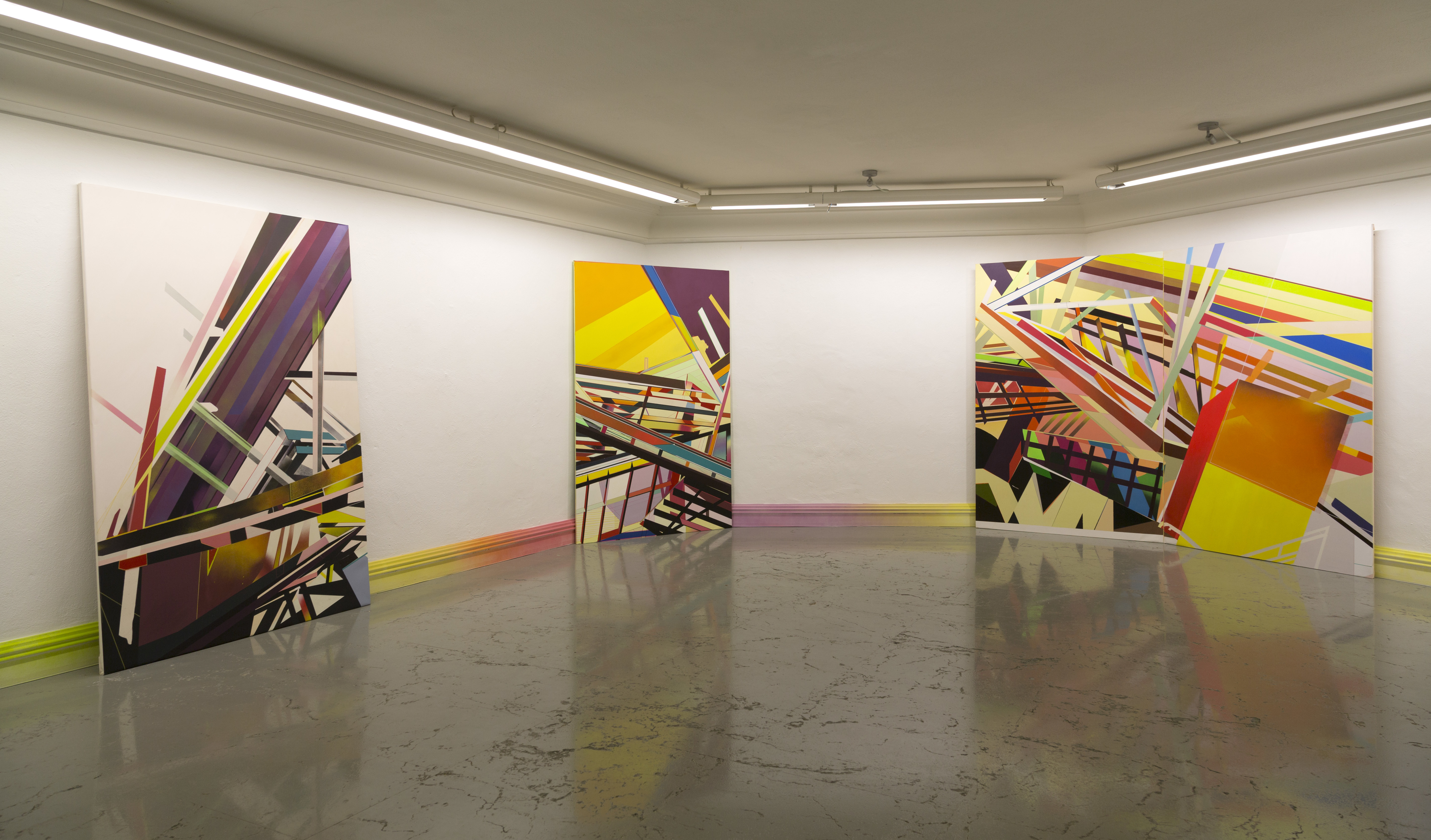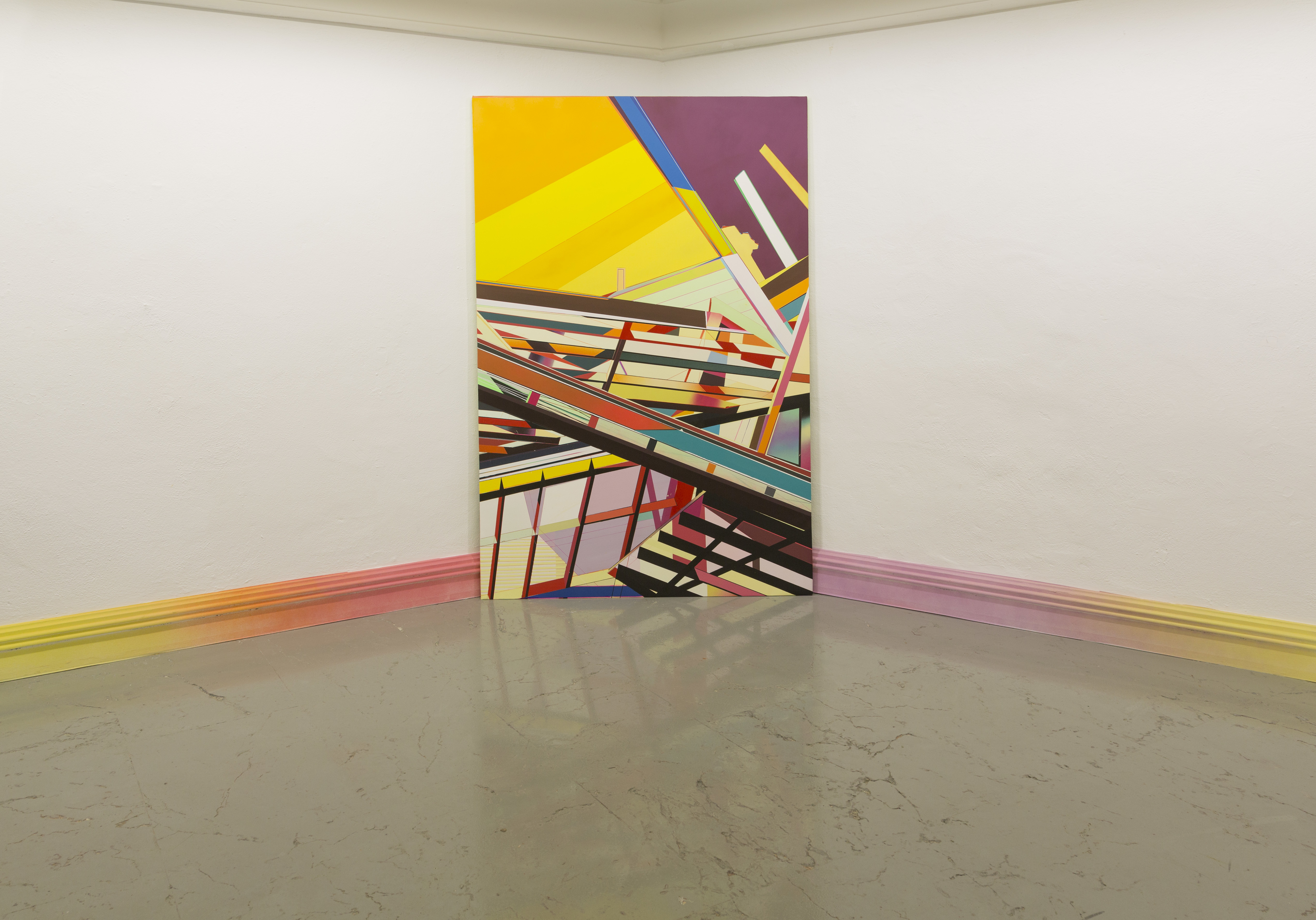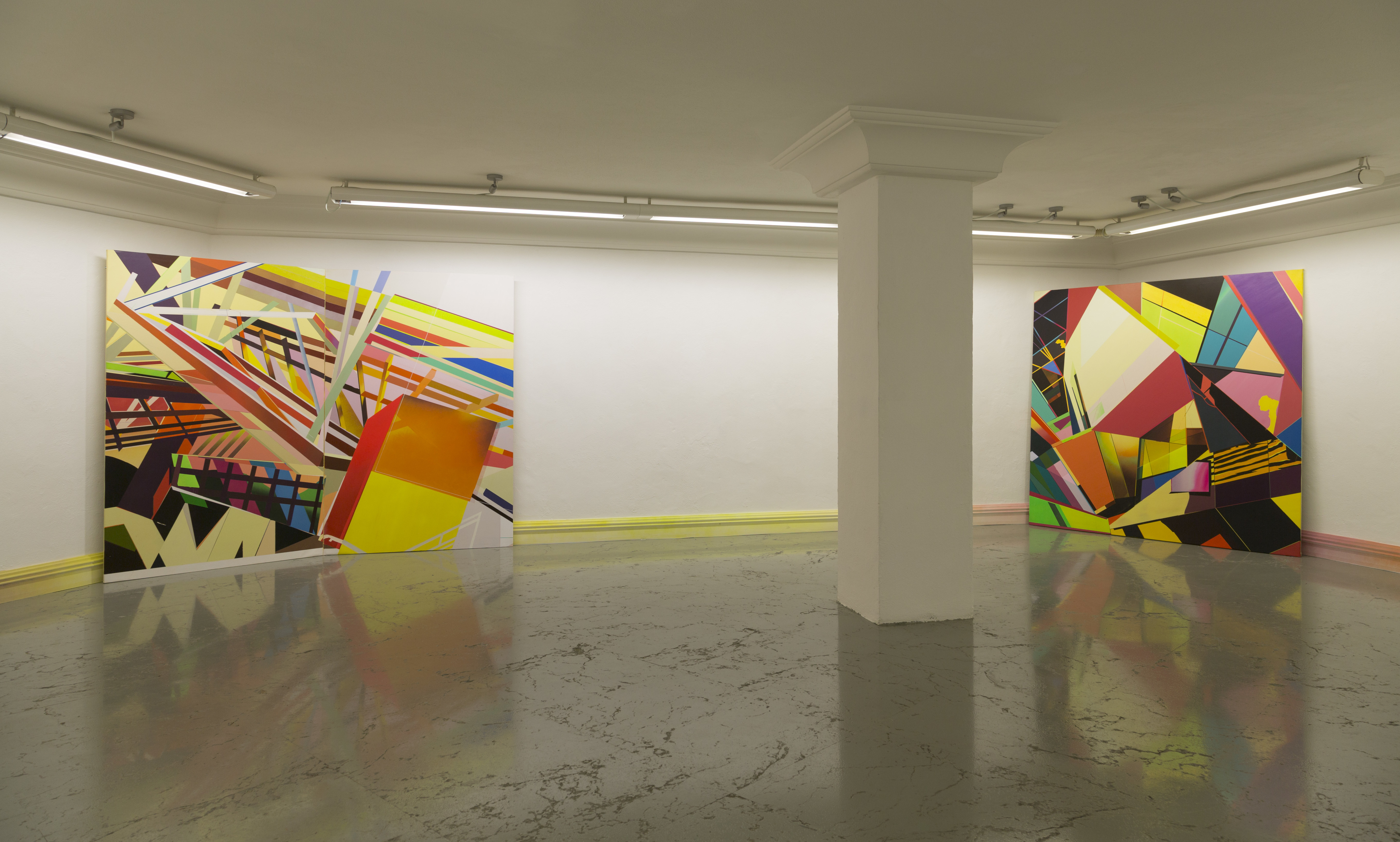







Modular Pavilion
Columna JM
2016
SCROLL DOWN FOR ENGLISH
Observaciones acerca del pabellón, el módulo y la pintura
El nombre del proyecto responde al interés del artista, Gonzalo Fuentes, por el pabellón que construyó Frank Gehry, allá por el año 2008, en los Kensington Gardens de la Serpentine Gallery londinense. En este caso, Gonzalo no fue a Londres en el momento en que este proyecto se llevó a cabo -recordemos que la Serpentine Gallery es el único centro del mundo que desarrolla un proyecto curatorial en torno a la arquitectura, y que los pabellones allí construidos están durante un periodo de tiempo determinado- sino que indagó en una serie de catálogos sobre arquitectura a la caza de esas imágenes que captaran su atención y que terminaran siendo referentes en sus pinturas -esta búsqueda es el modus operandi que desarrolla el artista desde su exposición Juegos de Construcción en la sala de exposiciones de la facultad de Bellas Artes de Málaga-. Decía Gehry sobre su pabellón que tomó referencias de las catapultas diseñadas por Leonardo (wooden catapults designed by Leonardo da Vinci) y de las casetas pintadas a rayas veraniegas que normalmente encontramos en la playa (striped walls of summer beach huts) para dotar al edificio -más bien estructura- de un ambiente dramático y espacialmente multidimensional (dramatic and multidimensional space). No obstante, el edificio -y espacio instalativo- está pensado para desarrollar distintas funciones, como dice el propio arquitecto, un anfiteatro (amphi-theater) y otra que se puede traducir como lugar de tránsito o de paseo (promenade)[1]. Ambas formas, destinadas a convertir el espacio arquitectónico en un lugar para la reflexión y el divertimento. Ello da a pensar que Gehry plantea la arquitectura como un lugar límite, entendida como forma en movimiento alejada de compartimentos racionales estándar. Un organismo vivo y mutable capaz de atraer a otros organismos -como los humanos- dejando su impronta los unos en los otros, aun que ésta a simple vista no se vea.
Si indagamos etimológicamente en el significado de la palabra pabellón vemos como su indefinición nos vuelve a situar en ese lugar de indeterminación antes mencionado. De entre sus múltiples significados destacaría uno que lo relaciona con la idea de módulo -o edificación provisional- que forma parte de un todo -que podría ser un recinto, una feria, una exposición, etc...- Así, un pabellón es 1.- una estructura temporal; 2.- un edificio aislado que forma parte de otra estructura mayor -como cuarteles, hospitales o cárceles, entre otras- o; 3.- extensas construcciones, ligeras y transparentes, que [forman] parte de grandes equipamientos -de nuevo hospitales, exposiciones, etc...-[2]. Podríamos decir, en este sentido, que su significado queda delimitado cerca de la idea de resto, aquello sobrante -esa idea antimoderna que se opone a lo total y completo, de un único significado- que se relaciona con lo provisional, lo efímero, lo fragmentado y lo múltiple. De esta forma, el pabellón se entremezcla con su exterior convirtiéndose en algo así como un recurso que nos sirve por tiempo limitado.
Paralelamente, si nos fijamos en su interior -lo que contiene-, sus posibilidades se disparan pudiendo adquirir aún muchos más sentidos. Si por ejemplo nos trasladamos al año 1937 -a modo de genealogía de lo que esto sería un pequeño fragmento- al Pabellón Español de la Exposición Universal de París vemos que, en este caso, su carácter museístico y político adquiere mucha relevancia. El edificio albergó en su interior pinturas -el Guernica de Picasso, que fue un encargo expreso de la República o, El campesino catalán en rebeldía de Miró, que se encuentra en paradero desconocido-, esculturas -la Fuente de mercurio de Calder, La Montserrat de Julio González o la de Alberto Sánchez El pueblo español tiene un camino que conduce a una estrella, de la cuál hay una reproducción a gran escala en la entrada principal del Museo Reina Sofía-, dibujos, grabados y una serie de cartelería propagandística que trataba de recabar apoyos del mundo libre que ayudaran a vencer al ejército sublevado. Un espacio cargado de sentido del cuál se conserva hoy día una réplica en Barcelona que alberga una biblioteca especializada sobre aquellos años. Esta genealogía nos reconduce de nuevo hacia el espacio ideado por Gehry ya que muestran del mismo modo ese interés por involucrar al individuo con aquello que está en su interior: recordemos un lugar de reflexión, transitable y lúdico, que enfatiza la idea de que el pabellón tiene la potencialidad de poder ser cualquier cosa.
Es partiendo de este sentido múltiple, que Gonzalo Fuentes se cuestiona la propia idea de la pintura a través de su trabajo. Lo que encontramos en su concepción de lo pictórico es un juego compositivo -que es el que lleva desarrollando desde sus inicios de apropiación de recursos y referentes de lo arquitectónico- que ahora, más que un juego, se ha convertido en una obsesión. Más que nunca en su pintura, los procedimientos técnicos de rarificación han conseguido que aquellas imágenes indiciales queden en una especie de límite impuesto, un limbo conceptual, donde luchan con lo compositivo por aparecer sin lograr conseguirlo. Eso provoca que ante nuestra mirada lo pictórico se dispare ya que el sentido no se puede contener. El proyecto ha sido planteado como un todo, donde las piezas independientes quedan descolocadas y donde la potencia discursiva radica en la acumulación, en lo modular, en el conjunto; en pensar la pintura como parte de un todo mayor. De esta manera, la pintura posee una intención de salirse de sí, esquizofrénica, de invadir su alrededor -modificándolo y modificándose a sí misma-, de generar otros espacios, otros sentidos que se afirman y se niegan al mismo tiempo, como en una novela. Dijo Schlegel en relación a la novela, que la ironía de un texto aparece cuando uno, en posición de lector, no conoce muy bien la intención de su autor, afirmando el texto una cosa al tiempo que bien puede significar lo opuesto. Finalmente, lo objetual se impone más allá de interpretaciones: pintura, pabellón y módulo.
Javier Bermúdez
1 Todas estas citas, entre paréntesis, están extraídas de la web: http://www.serpentinegalleries.org/exhibitions-events/serpentine-gallery-pavilion- 2008-frank-gehry-0
2 Definiciones extraídas de: https://definiciona.com/pabellon/
Observations about the pavilion, the module and the painting
The name of the project reflects the interest of the artist, Gonzalo Fuentes, in the pavilion built by Frank Gehry, back in 2008, in Kensington Gardens, at the London Serpentine Gallery. In this case, Gonzalo did not visit London at the time this project was carried out – note that the Serpentine Gallery is the only centre in the world that develops a curatorial project around architecture, and
the pavilions are built just for a certain period of time. Instead, he researched using a series of catalogues on architecture to search for images that could capture his attention and end up being representative in his paintings. This search has been the modus operandi of the artist since his exhibition Games of Construction, in the exhibition hall of the Department of Fine Arts of the
University of Malaga. Gehry said his pavilion took references from the wooden catapults designed by Leonardo da Vinci and from the striped walls of summer beach huts to endow the building, or rather the structure, of a dramatic and multidimensional space. However, the building, and also the installation space, is designed to develop different functions, as the architect himself says, an
amphitheatre and another that can be translated into a place of transit or promenade [1]. Both forms are designed to turn the architectural space into a place of reflection and fun. This suggests that Gehry understands architecture as a boundary, like a moving form away from standard rational compartments. A living and mutable organism capable of attracting other organisms, such
as humans, leaving their imprint on each other, even if the naked eye cannot see it.
If we look for the etymological origin of the word “pavilion”, its lack of definition returns us to that place of indeterminacy previously mentioned. Among its many meanings, I would focus on the one that relates to the idea of a module, or provisional building, that is part of a whole. This could be an enclosure, a fair, an exhibition, etc. Thus, a pavilion is 1) A temporary structure, 2) An isolated building that is part of another major structure, such as barracks, hospitals or prisons, among others, 3) Extensive constructions, light and transparent, part of great equipment, such as new hospitals, exhibitions, etc. [2] We could say, in this sense, that its meaning is limited to the idea of
remainder: the surplus, the anti-modern idea that opposes the total and complete, of a single meaning. This is also related to the provisional, the ephemeral, the fragmented and multiple. In this way, the pavilion is intermingled with its exterior, becoming a kind of resource that serves us for limited time.
At the same time, if we look at its interior, that is, what it contains, its possibilities are triggered with many more senses. For example, if we could travel to 1937, this would be a small fragment of the Spanish Pavilion of the Universal Exhibition in Paris. We see that, in this case, the museum and
political characters acquire great relevance. The building housed many paintings: Picasso's Guernica, which was an express order of the Republic, Miró's The Catalan peasant in revolt, which is nowadays in an unknown location, sculptures, such as Calder's Mercury Fountain, Julio González’s
La Montserrat, or Alberto Sánchez’s The Spanish people have a path that leads to a star (there is a large scale reproduction in the main entrance of the Reina Sofía Museum), drawings, engravings and a series of propaganda posters meaning to garner support from the free world to defeat the
revolted army. This is a space full of meaning. Today, a replica is preserved in Barcelona, with a library specialised in that period. This genealogy brings us back to the space devised by Gehry, since it shows the same interest in involving the individual with what is inside. Let us remember
this is a place of reflection, to walk and to play with, which emphasises the idea of the pavilion as the potential to be anything.
Looking at this multiple sense, Gonzalo Fuentes questions the very idea of painting through his work. We find a compositional game in his conception of the pictorial. This game has been developing since the beginning, and is related to the appropriation of resources and references of
the architectural. Now, more than a game, it has become an obsession. More than ever in his painting, the technical procedures of rarefication have succeeded in getting these initial images in a kind of imposed limit, a conceptual limbo. There, they struggle, without success, to exist with the
compositional. Before our eyes, the pictorial part raises up because sense cannot be contained. The project has been proposed as a whole: the independent pieces are left unoccupied, and the discursive power lies in the accumulation, in the modular, in the set. It also lies in the image of
painting as a part of a greater whole. In this way, painting intends to get out of itself, schizophrenic, to invade its surroundings, modifying them and modifying itself. It also intends to generate other spaces, other senses that are both affirmed and denied, as in a novel. In relation to novels, Schlegel
said that the irony of a text appears when a reader is not aware of the intention of the author, and the text affirms one thing while it can also mean the opposite. Finally, the “objectual” is impose beyond interpretations: painting, pavilion and module.
Javier Bermúdez
1 All the quotes in parentheses are taken from the web:
http://www.serpentinegalleries.org/exhibitions-events/serpentine- gallery-pavilion- 2008-frank- gehry-0
2 Definitions taken from: https://definiciona.com/pabellon/